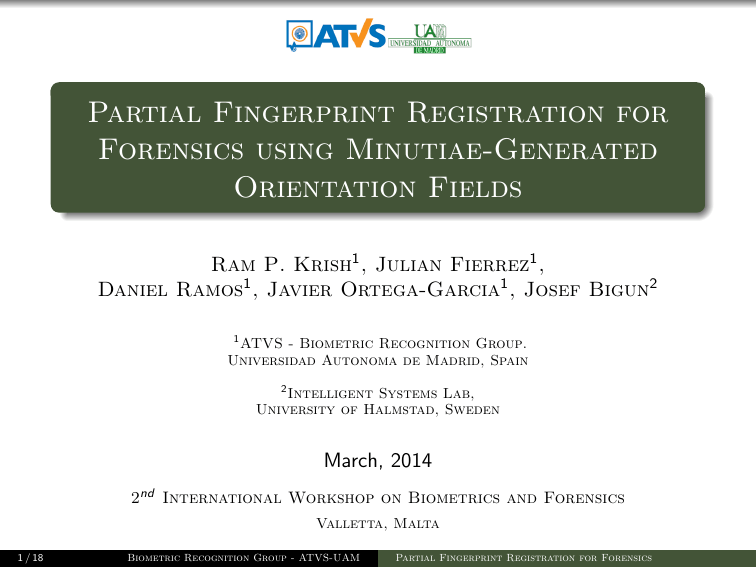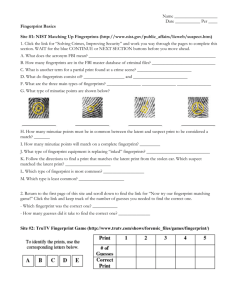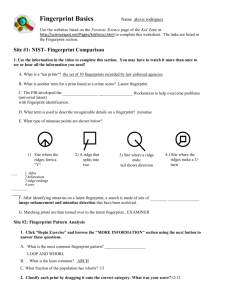Partial Fingerprint Registration for Forensics using Minutiae-Generated Orientation Fields Ram P. Krish
advertisement

Partial Fingerprint Registration for Forensics using Minutiae-Generated Orientation Fields Ram P. Krish1 , Julian Fierrez1 , Daniel Ramos1 , Javier Ortega-Garcia1 , Josef Bigun2 1 ATVS - Biometric Recognition Group. Universidad Autonoma de Madrid, Spain 2 Intelligent Systems Lab, University of Halmstad, Sweden March, 2014 2nd International Workshop on Biometrics and Forensics Valletta, Malta 1 / 18 Biometric Recognition Group - ATVS-UAM Partial Fingerprint Registration for Forensics Outline Introduction X Motivation X Problem statement Methods X Minutiae to Orientation Field X Correlation based pre-alignment (registration) Experiments X Database and Results Discussion 2 / 18 Biometric Recognition Group - ATVS-UAM Partial Fingerprint Registration for Forensics Introduction • Motivation X Comparing a partial fingerprint against a full fingerprint is a challenging problem. X Latent fingerprints lifted from crime scenes are mostly partial fingerprints in nature. X Minutiae based representation scheme is the most widely adapted representation scheme by many fingerprint matching systems. X Strict analogy with forensic friction ridge analysis. X Minutiae based decision is accepted as proof of identity legally by courts in almost all countries around the world. 3 / 18 Biometric Recognition Group - ATVS-UAM Partial Fingerprint Registration for Forensics Introduction † Problem statement X Automated minutiae based matching systems usually expects the size of minutiae set between query and reference is approximately the same. X It will be advantageous if we can reduce the minutiae search space of full fingerprint with respect to the partial fingerprint while comparison. How to go about reducing the search space in full fingerprint minutiae set w.r.t that of partial fingerprint? Robust pre-alignment using Orientation Field ? Orientation Field reconstructed from minutiae set ? Similarity measure based on normalized correlation This registration obtains extra information that can augment any minutiae based matcher. 4 / 18 Biometric Recognition Group - ATVS-UAM Partial Fingerprint Registration for Forensics Methods • Minutiae to Orientation Field X Orientation field (OF) reconstructed from minutiae. (J Feng, AK Jain, “Fingerprint Reconstruction: From Minutiae to Phase”, TPAMI, Feb 2011 ) X Minutiae generated OF is very similar to actual OF. X Reconstructed OF least affected due to noise in the fingerprint image. X Ability to reconstruct OF with only few minutiae (even if only 60% of minutiae is present). 5 / 18 Biometric Recognition Group - ATVS-UAM Partial Fingerprint Registration for Forensics Methods Minutiae to Orientation Field X An example of latent and tenprint OF reconstructed from its minutiae sets. (example from NIST SD-27 database) 6 / 18 Biometric Recognition Group - ATVS-UAM Partial Fingerprint Registration for Forensics Methods Minutiae to Orientation Field X For this example, the region in the tenprint that is to be found after registration. 7 / 18 Biometric Recognition Group - ATVS-UAM Partial Fingerprint Registration for Forensics Methods • Correlation based pre-alignment X Orientation tensors for both latent and tenprint. 8 / 18 Biometric Recognition Group - ATVS-UAM Partial Fingerprint Registration for Forensics Methods Correlation based pre-alignment X Correlating latent tensors in tenprint tensors. X To compensate for rotation alignment, latent tensors are rotated in range [−45◦ , 45◦ ] 9 / 18 Biometric Recognition Group - ATVS-UAM Partial Fingerprint Registration for Forensics Methods Correlation based pre-alignment X The region where latent pattern is identified in tenprint, location with maximum magnitude and minimum phase value in correlated result. 10 / 18 Biometric Recognition Group - ATVS-UAM Partial Fingerprint Registration for Forensics Methods Correlation based pre-alignment X Minutiae subset of tenprint selected by our registration algorithm, inside a circular region with radius defined by half the diagonal of the bounding box of latent pattern. 11 / 18 Biometric Recognition Group - ATVS-UAM Partial Fingerprint Registration for Forensics Experiments • Database NIST Special Database (SD) 27 X Publicly available forensic fingerprint database. X Broadly classified into 1) Ideal and 2) Matched minutiae database. X Ideal databases X Ideal latent consists of all minutiae manually extracted by forensic examiner. X Ideal impression consists of all minutiae extracted by AFIS, followed by manual validation by examiner. X Matched databases X Only contains those minutiae that are in common between the latent and its mated impression template. X There is a one-to-one correspondence between latent and its mate in matched templates. X Minutiae attribute consists of only location and orientation. X No type information available as minutiae attribute. 12 / 18 Biometric Recognition Group - ATVS-UAM Partial Fingerprint Registration for Forensics Experiments - Database • NIST SD-27 X Contains 258 latent fingerprint images and 258 mated tenprint images. X Latent fingerprint images are of varying qualities. X Classification based on subjective quality of latent fingerprint image: X Good - containing 85 images X Bad - containing 88 images X Ugly - containing 85 images X Classification based on total number of minutiae (n) in latent minutiae set: X Large - containing 83 images (n > 21) X Medium - containing 82 images (13 < n < 22) X Small - containing 93 images (n < 14) 13 / 18 Biometric Recognition Group - ATVS-UAM Partial Fingerprint Registration for Forensics Experiments - Protocol † Performance measurement X Registration algorithm finds a subregion in tenprint that best aligns latent and tenprint OF. X Based on this registration, a subset of minutiae from tenprint minutiae set is chosen. X The ground truth (matched) minutiae set in NIST SD-27 can be used to check how many of mated minutiae are present in this new subset. X We report the performance of our registration algorithm in terms of percentage of mated minutiae present in the new subset generated. 14 / 18 Biometric Recognition Group - ATVS-UAM Partial Fingerprint Registration for Forensics Results Subjective Classification X In average case scenario (without quality classification), 89% of entire database contains at least 75% of the mated minutiae in the new search space generated by our registration algorithm. Percent of database correctly identified 100 95 90 85 80 75 70 65 60 55 0 15 / 18 Average Good Bad Ugly 20 40 60 80 100 Minimum percent of matched minutiae in new search space Biometric Recognition Group - ATVS-UAM Partial Fingerprint Registration for Forensics Results Quantitative Classification Percent of database correctly identified 100 95 90 85 80 75 70 65 60 55 0 16 / 18 Average Large Medium Small 20 40 60 80 100 Minimum percent of matched minutiae in new search space Biometric Recognition Group - ATVS-UAM Partial Fingerprint Registration for Forensics Discussion Summary Performace of registration algorithm for selected threshold, all values in % Threshold Average Good Bad Ugly Large Medium Small 75 80 85 90 95 100 89 88 87 85 80 79 100 100 100 99 97 95 85 85 84 84 82 80 82 79 77 70 62 60 97 97 97 97 97 94 94 94 93 90 84 82 78 76 74 69 63 62 Using our registration algorithm, we can obtain extra information that can augment minutiae based matcher by reducing the search space for Good quality latents. The deteriorated performance in case of Bad and Ugly classification is due to few number of minutiae and the degraded quality of estimated OF. Future work : A detailed analysis on how this registration algorithm can be incorporated to improve the identification of minutiae-based matcher. 17 / 18 Biometric Recognition Group - ATVS-UAM Partial Fingerprint Registration for Forensics 18 / 18 Biometric Recognition Group - ATVS-UAM Partial Fingerprint Registration for Forensics





